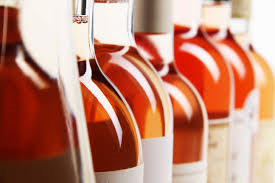 Rosé wine.
Rosé wine.
Take it on a picnic. Pair it with your favorite dish. Share with friends…or keep it all for yourself. I’m loving the amazing rosés coming out of the Central Coast Wine Regions. But what makes a rosé a rosé? Is it a red wine or a white? And how does it get that beautiful color?
A rosé (from French rosé; rosado in Portugal and Spanish-speaking countries; rosato in Italy) is a type of wine made from red grape varietals that incorporates some of the color from the grape skins, but not enough to qualify it as a red wine. It may be the oldest known type of wine, as it is the most straightforward to make with the skin contact method. The pink color can range from a pale orange to a deeper near-purple, depending on the grapes used and winemaking techniques. There are three major ways to produce rosé wine: skin contact, saignée (pronounced san-yay) and blending. Rosé wines can be made still, semi-sparkling or sparkling and with a wide range of sweetness levels from bone-dry to sweet. Rosé wines are made from a wide variety of grapes and can be found all around the globe. Here on the Central Coast winemakers favor Pinot Noir, Syrah, and Grenache for their rosés, but I’ve seen Zinfandel, Sangiovese and even Malbec rosés. For some local favorites check out our local Edible SLO Magazine for their top picks. The possibilities are endless!
When a winemaker sets out with the goal to make a Rosé it is usually produced with the skin contact method. Black-skinned grapes are crushed and the skins are allowed to remain in contact with the juice for a short period, usually one to three days. The must (skins and juice) is then pressed, and the skins are discarded rather than left in contact throughout fermentation, as is common in red wine making. The final color of the Rosé depend on how long the juice has contact with the skins. Longer contact = deeper color.
Saignée occurs when a winemaker uses the pink juice removed from red wine during the winemaking process. In French Saignée means ‘to bleed’. To impart more tannin and color to a red wine, winemakers remove (or bleed off) some of the pink juice from the must as a way of concentrating the red wine. The red wine remaining in the vats is intensified as a result of the bleeding, because the volume of juice in the must is reduced, and the must involved in the maceration becomes more concentrated. The pink juice that is removed can be fermented separately to produce Rosé.
In other parts of the world, blending, the simple mixing of red wine to a white to impart color, is uncommon. This method is discouraged in most wine  growing regions, especially in France, where it is forbidden by law, except for Champagne. Even in Champagne, several high-end producers do not use this method but rather the Saignée method.
growing regions, especially in France, where it is forbidden by law, except for Champagne. Even in Champagne, several high-end producers do not use this method but rather the Saignée method.
So, now you’re officially versed in the basics of rosé! The next time you’re in your favorite tasting room sampling a glass o’ the pink, ask your pourer whether their winemaker prefers the skin contact method, or if its a Saignée you’re sipping. You will learnn a lot about winemaking techniques and look super savvy in front of your friends!
I recommend swinging by Beckmen Vineyards in Santa Ynez for their 2014 Grenache Rosé $25, Claiborne & Churchill Winery in Edna Valley for their 2012 Cuvee Elizabeth Rosé $24 (I actually bribe my sister with bottles of this wine) or Tablas Creek Winery in Paso Robles for their 2014 Dianthus Rosé $27.


